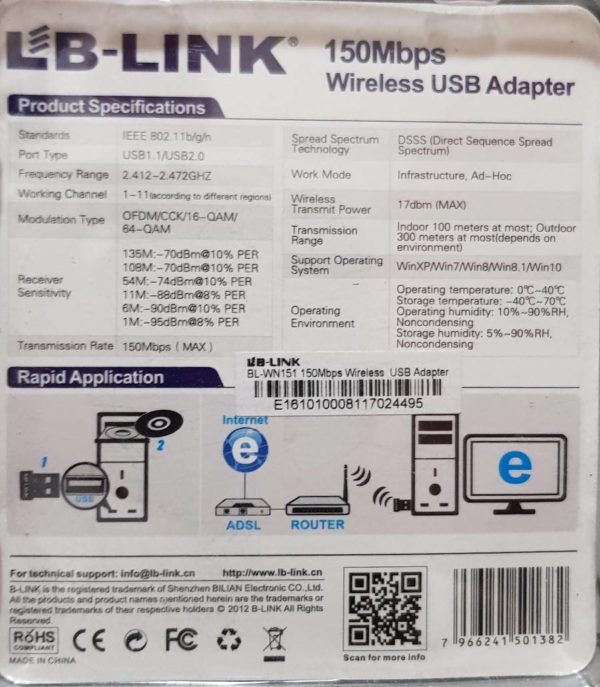
Lb Link 802.11N For Lg Pad Download PDF Info
ASSIGNMENT OF ASSIGNORS INTEREST (SEE DOCUMENT FOR DETAILS). Reassignment SAMSUNG ELECTRONICS CO., LTD. Google has not performed a legal analysis and makes no representation as to the accuracy of the date listed.) Filing date Publication date Application filed by Samsung Electronics Co Ltd filed Critical Samsung Electronics Co Ltd Priority to US11/313,906 priority Critical patent/US7584406B2/en Assigned to SAMSUNG ELECTRONICS CO., LTD. Google has not performed a legal analysis and makes no representation or warranty as to the accuracy of the list.)Original Assignee Samsung Electronics Co Ltd Priority date (The priority date is an assumption and is not a legal conclusion. Google has not performed a legal analysis and makes no representation as to the accuracy of the status listed.) Expired - Fee Related, expires Application number US11/313,906 Other versions US20070143656A1( en Inventor Huaning Niu Chiu Ngo Current Assignee (The listed assignees may be inaccurate. US7584406B2 - LDPC concatenation rules for IEEE 802.11n system with packets length specific in octets- Google Patents US7584406B2 - LDPC concatenation rules for IEEE 802.11n system with packets length specific in octets- Google Patents LDPC concatenation rules for IEEE 802.11n system with packets length specific in octetsDownload PDF Info Publication number US7584406B2 US7584406B2 US11/313,906 US31390605A US7584406B2 US 7584406 B2 US7584406 B2 US 7584406B2 US 31390605 A US31390605 A US 31390605A US 7584406 B2 US7584406 B2 US 7584406B2 Authority US United States Prior art keywords shortening bits puncturing codewords ldpc Prior art date Legal status (The legal status is an assumption and is not a legal conclusion.
241000558265 Pandaceae Species 0.000 description 11 230000001702 transmitter Effects 0.000 claims description 9 238000000034 method Methods 0.000 claims description 15 230000005540 biological transmission Effects 0.000 claims description 22 238000004904 shortening Methods 0.000 claims abstract description 70
230000000875 corresponding Effects 0.000 description 2 239000000969 carriers Substances 0.000 description 2 238000004364 calculation methods Methods 0.000 description 2 230000002776 aggregation Effects 0.000 description 3 238000004220 aggregation Methods 0.000 description 3
238000010586 diagrams Methods 0.000 description 1 230000000593 degrading Effects 0.000 description 1 238000004422 calculation algorithm Methods 0.000 description 1
H03M13/03— Error detection or forward error correction by redundancy in data representation, i.e. H03M13/00— Coding, decoding or code conversion, for error detection or error correction Coding theory basic assumptions Coding bounds Error probability evaluation methods Channel models Simulation or testing of codes H03M— CODING DECODING CODE CONVERSION IN GENERAL 238000004088 simulation Methods 0.000 description 1
A predetermined number of check bits joined to a predetermined number of information bits Code words containing more digits than the source words using block codes, i.e. H03M13/05— Error detection or forward error correction by redundancy in data representation, i.e.

H03M13/6362— Error control coding in combination with rate matching by puncturingCurrently, LDPC code is considered for in the high throughput wireless local area networks (WLAN), such as IEEE 802.11n, as an optional advanced code to improve system throughput. H03M13/635— Error control coding in combination with rate matching H03M13/63— Joint error correction and other techniques H03M13/618— Shortening and extension of codes H03M13/61— Aspects and characteristics of methods and arrangements for error correction or error detection, not provided for otherwise H03M13/31— Coding, decoding or code conversion, for error detection or error correction Coding theory basic assumptions Coding bounds Error probability evaluation methods Channel models Simulation or testing of codes combining coding for error detection or correction and efficient use of the spectrum
Since transported data packets can be any size from typically about 40 bytes up to 12000 bytes and larger, the WLAN system must be able to encode packets with variable lengths in a consistent manner. A method for concatenating the LDPC codeword within a PPDU is an important design issue. Second, in high-throughput WLAN systems, the transmitted PPDU (Physical Protocol Data Unit) is large, which requires using several LDPC codewords. Therefore, the largest code size is limited to around 2K bits. However, since a WLAN system is a random access based system, the code size is limited by the SIFS (Short Inter-Frame Space) decoding budget. Since LDPC code works better with longer code size, the code size should be selected as large as possible to ensure performance.
Determine the number of codewords, N CWORDS, to transmit. The procedure for encoding N INFO — BITS=HT-LENGTH*8 includes the following steps: For low data rate transmission, both shortening and puncturing are applied. If N DBPS is above a pre-defined threshold (high data rate), only shortening is used, which is similar to the WWiSE approach above.
Step 200: Initialize the concatenation process. 2 shows an implementation of the above two primary processes, wherein steps 200 through 202 implement the first primary process, and steps 204 through 210 implement the second primary process, including: In some cases it may be required that the last codeword has different number of data and parity bits, K 1 — LAST and M 1 — LAST, respectively, (and consequently N PAD — CW — LAST and N PUNCTURE — CW — LAST) than the other codewords.An example of the concatenation rule includes two primary processes of: (1) choosing the appropriate code word from all the candidate code words based on the packet payload size, wherein the payload size is the number of transmitted information bits in octets, and (2) applying shortening and puncturing across all codewords within the packet to minimize the extra OFDM padding required while maintaining the coding performance. This, in turn, determines by how many bits to shorten information portion of the codeword (number of zeros to pad the information field), N PAD — CW, as well as how many bits to puncture (remove bits from the parity portion of the codeword), N PUNCTURE — CW.
Step 204: Determine criterion for applying shortening and puncturing and determine process to compute the shortening to puncture ratio (use of the shortening-to-puncturing ratio is discussed in commonly assigned patent application Ser.


 0 kommentar(er)
0 kommentar(er)
